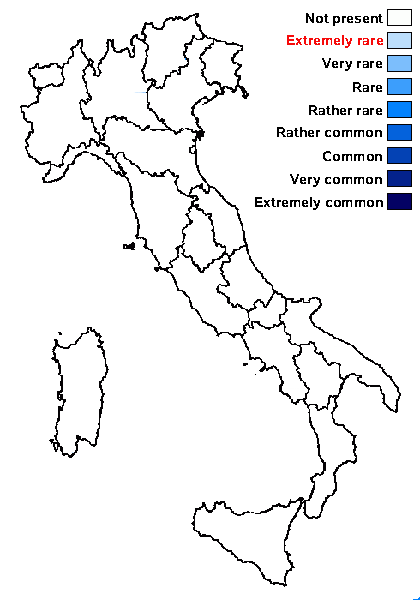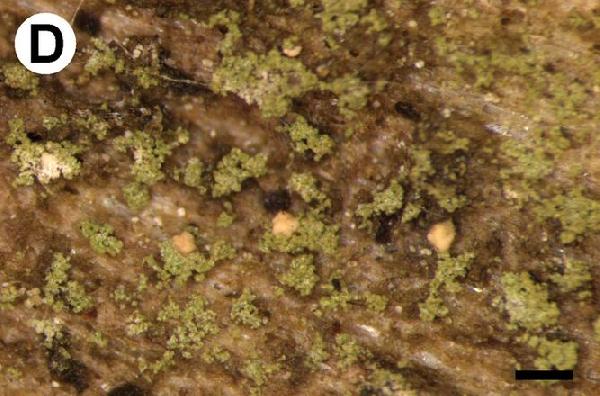Micarea microsorediata M. Brand, van den Boom, Guzow-Krzem., Sérus. & Kukwa
in Guzow-Krzemińska & al., MycoKeys, 57: 19, 2019.
Synonyms:
Distribution:
Description: Thallus crustose, thinly episubstratic, green, sometimes with a bluish tinge, areolate-sorediate, forming up to 10 cm wide patches, the areoles convex, up to 25 µm wide, soon bursting to produce finely granular, up to 20 µm wide soredia that often are gathered into up to up 35 µm wide consoredia, the soralia at first delimited but soon confluent, sometimes forming a sorediate continuous layer; internal crystals soluble in K and visible under polarized light present in thallus. Apothecia very rare, micareoid, adnate, at first with an indistinct margin, then emarginate, 0.2-0.3 mm across, white or pale brown. Proper exciple evident only in young apothecia, 15-25 µm wide, of thin irregular hyphae; epithecium colourless, K-, without crystals; hymenium colourless, c. 30-42 µm high, with crystals visible under polarized light; paraphyses branched and anastomosing, c. 1.2-1.5 µm thick; hypothecium colourless. Asci 8-spored, clavate to cylindrical-clavate, in K/I with a blue outer layer and apical dome and unstained wall, the dome with an apical cushion, 29-35 x 7-10 µm. Ascospores (0-)1-septate, hyaline, cylindrical to ellipsoid, 9.5-13 x 2.8-3.5 µm. Micropycnidia rather rare, c. 60 µm in diam., with dark brown tips reacting K-. Microconidia narrowly fusiform to bacilliform, c. 7 x 0.8 µm; mesoconidia c. 3.8 x 1.4 µm. Photobiont micareoid, the cells thin-walled, 4-8(-9) µm wide. Spot tests: thallus K- or K+ faintly violet, C-, KC-, P-, UV-. Chemistry: methoxymicareic acid. Soredia in exposed habitats with the Sedifolia-grey pigment. Note: a recently-described, mostrly sterile species growing on acid bark, more rarely on lignum and plant debris, known from several stations in Central Europe and from Portugal. To be looked for in Italy.
Growth form: Crustose
Substrata: bark and lignum
Photobiont: green algae other than Trentepohlia
Reproductive strategy: mainly asexual, by soredia, or soredia-like structures (e.g. blastidia)

Predictive model

Source: Guzow-Krzemińska B, Sérusiaux E, van den Boom PPG, Brand AM, Launis A, Łubek A, Kukwa M (2019) Understanding the evolution of phenotypical characters in the Micarea prasina group (Pilocarpaceae) and descriptions of six new species within the group. MycoKeys 57: 1-30. - CC BY-4.0
D M. microsorediata (holotype) Scale bar: 300 µm
Growth form: Crustose
Substrata: bark and lignum
Photobiont: green algae other than Trentepohlia
Reproductive strategy: mainly asexual, by soredia, or soredia-like structures (e.g. blastidia)

Predictive model


